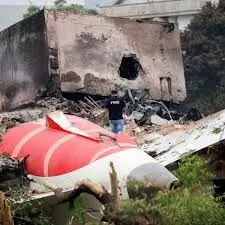Air India Flight 171 Crash: FAA and Boeing Assert Fuel Switch Locks Are Safe Despite Probe Findings
FAA and Boeing affirm fuel switch safety after Air India Flight 171 crash; AAIB raises concerns on accidental engine shutdown. Probe ongoing.
image for illustrative purpose

In the wake of the tragic Air India Flight 171 crash, which claimed 260 lives on June 12, 2025, the U.S. Federal Aviation Administration (FAA) and Boeing have reaffirmed the safety of the fuel control switch locks on Boeing aircraft. This response comes after India’s Aircraft Accident Investigation Bureau (AAIB) released a preliminary report raising concerns about possible accidental activation of the switches, leading to dual engine failure shortly after takeoff.
FAA, Boeing Stand Firm on Fuel Switch Safety
According to a Reuters report, the FAA privately issued a Continued Airworthiness Notification to civil aviation authorities worldwide on July 11, stating that the design of the fuel switch locks on Boeing aircraft, including the Boeing 787-8 Dreamliner, does not pose a safety risk requiring an Airworthiness Directive (AD).
"Although the fuel control switch design, including the locking feature, is similar on various Boeing airplane models, the FAA does not consider this issue to be an unsafe condition that would warrant an Airworthiness Directive," the notification reads.
Boeing has also echoed the FAA’s position in a communication sent to airlines, affirming no further action is necessary.
AAIB Report Questions Prior Safety Oversight
The AAIB investigation referenced a 2018 FAA Special Airworthiness Information Bulletin (SAIB No. NM-18-33), which recommended—but did not mandate—airlines inspect the fuel control switch locking mechanisms to ensure they could not be inadvertently activated.
Notably, Air India did not perform these inspections, as the guidance was advisory and not compulsory. Maintenance records show that the aircraft’s throttle control module, housing the fuel switches, had been replaced twice—in 2019 and 2023.
“The airworthiness concern was not considered an unsafe condition by the FAA. The inspections were not carried out as the SAIB was advisory in nature,” the AAIB report noted.
What Are Fuel Control Switches?
Fuel control switches regulate fuel supply to an aircraft’s engines. On the Boeing 787-8, like the one involved in the crash, these switches are located below the thrust levers and are crucial for engine start-up, shutdown, and emergency procedures. Experts say they are designed with lock mechanisms to prevent accidental engagement.
However, according to the AAIB, both engine fuel switches moved from RUN to CUTOFF just one second apart, moments after the aircraft reached a speed of 180 knots during takeoff.
“The aircraft achieved a maximum speed of 180 knots… and immediately thereafter, both fuel cutoff switches transitioned from RUN to CUTOFF with a one-second gap,” the report stated.
A cockpit voice recorder captured one pilot asking, “Why did you shut off the fuel?” to which the other responded, “I did not do so.”
Though the switches were flipped back to ‘RUN’ after 14 seconds, the engines had already lost power. The aircraft crashed into a nearby building 32 seconds after takeoff, despite a MAYDAY distress call.
Indian Pilots' Association Demands Fair Inquiry
The Airline Pilots’ Association of India (ALPA India) has called for a “fair, fact-based inquiry,” rejecting the presumption of pilot error and advocating for pilot representation in the investigation.
“The tone and direction of the investigation suggest a bias toward pilot error. ALPA categorically rejects this presumption,” said Capt. Sam Thomas, ALPA India President.
He stressed that the fuel switch gates issue highlighted in the 2018 FAA bulletin suggests a potential equipment malfunction.
Key Findings from Preliminary Report:
- Fuel switches moved to cutoff seconds after takeoff.
- Throttle control module replaced twice in previous years.
- Auto relight sequence initiated, but engines failed to recover.
- Ram Air Turbine (RAT) deployed, confirming full engine failure.
- No evidence of bird strikes or external obstruction.
- Crash occurred 32 seconds after takeoff.
Conclusion
While Boeing and the FAA maintain that the fuel switch locks are safe and do not require design changes, the preliminary AAIB findings and mounting pressure from pilots' associations highlight the urgent need for a comprehensive, unbiased investigation. With safety at the forefront, all stakeholders are being urged to collaborate and ensure that any possible mechanical or human errors are addressed transparently.

